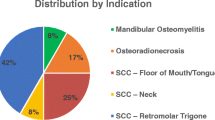Abstract.
The free microvasclar fibula and soft tissue transfer has become a widely used method to reconstruct the head and neck region. Only few reports focus on the donor site morbidity of purely mandibular reconstructions. On the basis of the hospital charts, a standardized patient interview and a standardized physical examination, the present study evaluates the early and late donor site morbidity in 42 mostly oncologic patients after an average follow-up interval of 34 months. Of these, 16 patients (38.1%) exhibited complicated wound healing that did not correlate with the patient's age, sex, type of transplant, use of a skin graft, result of preoperative angiography, rate of postoperative mobilization or the incidence of late donor site morbidity. At the time of follow-up examination, about one-fourth of the patients reported discomfort, pain or swelling. Objective findings included sensory deficits in 76.3%, motor deficits in 39.5% and reduced strength in 44.7% of the patients. Even though objectively measured morbidity exceeded subjectively perceived morbidity, it can be concluded that there is significant early and late donor site morbidity, which should be considered when opting for a fibula graft. Patients should be informed accordingly.
Similar content being viewed by others
Author information
Authors and Affiliations
Additional information
Electronic Publication
Rights and permissions
About this article
Cite this article
Zimmermann, C., Börner, BI., Hasse, A. et al. Donor site morbidity after microvascular fibula transfer. Clin Oral Invest 5, 214–219 (2001). https://doi.org/10.1007/s00784-001-0140-5
Received:
Accepted:
Published:
Issue Date:
DOI: https://doi.org/10.1007/s00784-001-0140-5




